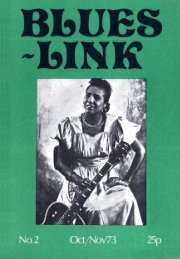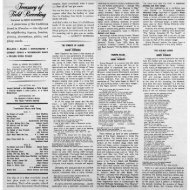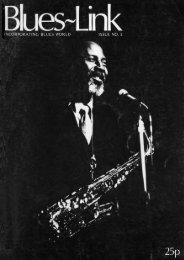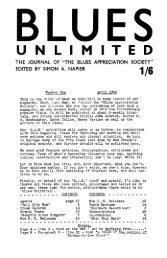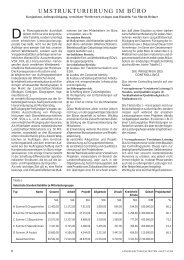The Blues Collection 84: EAST COAST BLUES.- Orbis Publishing ...
The Blues Collection 84: EAST COAST BLUES.- Orbis Publishing ...
The Blues Collection 84: EAST COAST BLUES.- Orbis Publishing ...
Create successful ePaper yourself
Turn your PDF publications into a flip-book with our unique Google optimized e-Paper software.
<strong>EAST</strong> <strong>COAST</strong> <strong>BLUES</strong><br />
ABOVE: 'Colonel’ Bill Williams claimed that while working as part of a road gang in<br />
the early 1920s, he was sought out by fellow guitar-picker Blind Blake and that<br />
they became a popular duo playing for Williams’ fellow workers. One of Williams’<br />
most intriguing pieces was a ragtime interpretation of '<strong>The</strong> Star-Spangled Banner’.<br />
clubs and studios with his partner<br />
Sonny Terry. McGhee can hardly be<br />
called an East C oaster: he grew up<br />
around th e E ast T e n n e ssee c itie s<br />
Knoxville and Kingsport, but his incessant<br />
travelling made him familiar with<br />
all the music one might hear in Appalachia<br />
and on the eastern seaboard.<br />
A UNIFYING LANGUAGE<br />
<strong>The</strong> M cG hee-Terry sound, with its<br />
smooth interlocking of guitar and harmonica,<br />
would grow over the years<br />
into a kind of B asic English of the<br />
blues, spoken everywhere from New<br />
York to Newcastle. We can hear a version<br />
of it as early as the early 1940s in<br />
the few o b sc u re but ca p tiv atin g<br />
record ings by Skoodle Dum Doo &<br />
Sheffield, the former a 12-string-guitar<br />
playing bluesman from way back - he<br />
had first recorded in 1928 - named<br />
Seth Richard or Richards.<br />
Fifty years on, the com bination is<br />
refreshed and recast in the partnership<br />
of singer-guitarist John Cephas<br />
and harp-player Phil Wiggins. Cephas,<br />
born in Washington DC in 1930, was<br />
raised in Bowling Green, Virginia, and<br />
learned som e of his trade from the<br />
pianist W ilbert ‘Big C hief Ellis, who<br />
had worked with McGhee in the 1940s.<br />
Beginning th e ir co lla b o ra tio n in<br />
1978, Cephas and Wiggins gradually<br />
moved from straightforward McGhee-<br />
Terry stylings to a subtler approach,<br />
informed by deep knowledge of the<br />
en tire blues legacy. A 1995 album,<br />
Cool Down (Alligator), finds Cephas<br />
engaged in experim ents like playing<br />
Skip Jam es’ ‘Special Rider’ in duet with<br />
Senegalese kora player Djimo Kouyate.<br />
1004<br />
It seem s som ehow appropriate to<br />
bring Keb’ Mo’ in here. Kevin Moore,<br />
as he started out, was born in Los<br />
Angeles in the early 1950s. Both his<br />
parents were from the southwest and<br />
his early musical experiences included<br />
playing guitar with the violinist Papa<br />
John Creach and portraying Robert<br />
Johnson in a movie docudrama.<br />
Not a whiff of East Coast air so far -<br />
but in his remarkable mid-1990s transformation<br />
into a postmodern acoustic<br />
bluesman Keb’ Mo’ has acquired an<br />
airy ease that surely owes something<br />
to m odels like Fuller and M cGhee,<br />
esp ecially when he plays a vintage<br />
National steel guitar just like Fuller’s.<br />
And here and there in his albums K eb ’<br />
Mo ’ and Ju st Like You he also evinces<br />
a d e lica te ragtim e se n sib ility th at<br />
would have been fam iliar to Luke<br />
Jordan or William Moore.<br />
K ing g u ita r<br />
It will be apparent by now that the guitar<br />
lorded it over other instruments<br />
even more in the southeast than elsewhere.<br />
Or so it seems from the recorded<br />
evidence but, as always, this is a<br />
h isto rical hot p otato: w ere guitars<br />
really ubiquitous, or did recording<br />
scouts simply shake their heads at the<br />
fiddlers, banjoists and piano players<br />
who turned up for auditions?<br />
A few pianists did make it through<br />
the net, like the Savannah, Georgia,<br />
player Sugar Underwood, or Curtis<br />
Henry and ‘Peg-Leg’ Ben Abney, who<br />
recorded in Charlotte in the 1930s (but<br />
may not have been locals). But there<br />
appears to have been no pianists’ circuit,<br />
as in the Texas logging camps, to<br />
su stain a tra d itio n of b arrelh o u se<br />
blues. <strong>The</strong> piano-players who ruled the<br />
New York blues scene of the 1940s and<br />
1950s were from elsewhere: Big Chief<br />
Ellis from Alabama, Jack Dupree from<br />
New Orleans.<br />
What emerges from the research of<br />
the writer Bruce Bastin is a detailed<br />
map of untapped talent: fiddlers and<br />
banjo players whose music, even in<br />
the 1920s, seemed to the record companies<br />
to be too archaic to become







